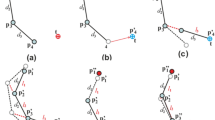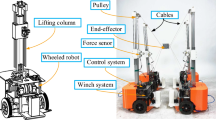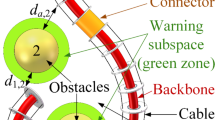Abstract
This paper presents a reliable algorithm for solving the inverse kinematic (IK) problem of continuum robots. Admittedly, there are an infinite number of configurations to get the robot’s end point (EP) pose. Therefore, the proposed algorithm introduces a new solution that helps narrow the infinite number of the IK solutions down to a finite one by taking into account the first \((n-1)\) sections’ sets of reachable EP poses, which are selected and created one-by-one from the first to \((n-1)\)th section, in which the Particle Swarm Optimization method is adopted to randomly pick up the first IK solution. However, a specific criterion has been accorded to select the appropriate IK solution (i.e., redundancy resolution) among the existing varieties that perfectly fits within the targeted trajectory. Furthermore, numerical experiments are performed on a Cable-Driven Continuum Robot for tracking a trajectory in a free and confined environment, pointing up on IK, multiple IK solutions and redundancy resolution. The obtained results demonstrated that the proposed algorithm is computationally accurate and efficient in obtaining all-inclusive IK solutions and redundancy resolution of continuum robots in comparison to previously proposed approaches. It is noteworthy to say that the proposed algorithm can be applied to any kind of continuum robots and most importantly regardless of its number of sections, which makes the developed algorithm a sovereign remedy for the IK problem of these robots.








Similar content being viewed by others
References
Seleem, I.A.; El-Hussieny, H.; Assal, S.F.M.; Ishii, H.: Development and stability analysis of an imitation learning-based pose planning approach for multi-section continuum robot. IEEE Access. 8, 99366–99379 (2020). https://doi.org/10.1109/ACCESS.2020.2997636
Li, H.; Yao, J., et al.: A bioinspired soft swallowing robot based on compliant guiding structure. Soft Robot. 7, 491–499 (2020). https://doi.org/10.1089/soro.2018.0154
Ma, X.; Song, C.; Chiu, W.Y.P.; Li, Z.: Autonomous flexible endoscope for minimally invasive surgery with enhanced safety. IEEE Robot. Autom. Lett. 4, 2607–2613 (2019). https://doi.org/10.1109/LRA.2019.2895273
Alfalahi, H.; Renda, F.; Stefanini, C.: Concentric tube robots for minimally invasive surgery: current applications and future opportunities. IEEE Trans. Med. Robot. Bionics. 2, 410–424 (2020). https://doi.org/10.1109/TMRB.2020.3000899
Zhang, Y.; Lu, M.: A review of recent advancements in soft and flexible robots for medical applications. Int. J. Med. Robot. Comput. Assist. Surg. (2020). https://doi.org/10.1002/rcs.2096
Mingfeng, W.; Xin, D.; Weiming, B.; Abdelkhalick, M.; Dragos, A.; Andy, N.: Design, modelling and validation of a novel extra slender continuum robot for in-situ inspection and repair in aeroengine. Robot. Comput. –Integr. Manuf. (2021). https://doi.org/10.1016/j.rcim.2020.102054
Kolachalama, S.; Lakshmanan, S.: Continuum robots for manipulation applications: a survey. J. Robot. 2020(4187048), 19 (2020). https://doi.org/10.1155/2020/4187048
Niu, G.; Zhang, Y.; Li, W.: Path planning of continuum robot based on path fitting. J. Control Sci. Eng. 2020(8826749), 11 (2020). https://doi.org/10.1155/2020/8826749
Bousbia, L.; Amouri, A.; Cherfia, A.: Dynamics modeling of a 2-DoFs cable-driven continuum robot. World J. Eng. (2022). https://doi.org/10.1108/WJE-01-2021-0028
Rao, P.; Peyron, Q.; Lilge, S.; Burgner-Kahrs, J.: How to model tendon-driven continuum robots and benchmark modelling performance. Front. Robot. AI (2021). https://doi.org/10.3389/frobt.2020.630245
Mahl, T.; Hildebrandt, A.; Sawodny, O.: A variable curvature continuum kinematics for kinematic control of the bionic handling assistant. IEEE Trans. Rob. 30(4), 935–949 (2014). https://doi.org/10.1109/TRO.2014.2314777
Abdel-Nasser, M.; Salah, O.: New continuum surgical robot based on hybrid concentric tube-tendon driven mechanism. Proc. Inst. Mech. Eng. C J. Mech. Eng. Sci. 235(24), 7550–7568 (2021). https://doi.org/10.1177/09544062211042407
Mishra, M.K.; Samantaray, A.K.; Chakraborty, G.; Pachouri, V.; Pathak, P.M.; Merzouki, R.: Kinematics model of bionic manipulator by using elliptic integral approach. In: Kumar, R.; Chauhan, V.S.; Talha, M.; Pathak, H. (Eds.) Machines, Mechanism and Robotics. Lecture Notes in Mechanical Engineering. Springer, Singapore (2022). https://doi.org/10.1007/978-981-16-0550-5_30
Webster, R.J.; Jones, B.A.: Design and kinematic modeling of constant curvature continuum robots: a review. Int. J. Robot. Res. 29(13), 1661–1683 (2010). https://doi.org/10.1177/0278364910368147
Santina, C.D.; Rus, D.: Control oriented modeling of soft robots: the polynomial curvature case. IEEE Robot. Autom. Lett. 5, 290–298 (2020). https://doi.org/10.1109/LRA.2019.2955936
Huang, S.; Meng, D.; Wang, X.; Liang, B.; Lu, W.: A 3D static modeling method and experimental verification of continuum robots based on pseudo-rigid body theory. In: IEEE International Conference on Intelligent Robots and Systems, Macau, China, (2019). https://doi.org/10.1109/IROS40897.2019.8968526.
Neppalli, S.; Csencsits, M.A.; Jones, B.A., et al.: Closed-form inverse kinematics for continuum manipulators. Adv. Robot. 23, 2077–2091 (2012). https://doi.org/10.1163/016918609X12529299964101
Chirikjian, G.S.; Burdick, J.W.: A modal approach to hyper-redundant manipulator kinematics. IEEE Trans. Robot. Autom. 10(3), 343–354 (1994). https://doi.org/10.1109/70.294209
Zhao, B.; Zeng, L.; Wu, B.; Xu, K.: A continuum manipulator with closed-form inverse kinematics and independently tunable stiffness. In: IEEE International Conference on Robotics and Automation (ICRA). 1847–1853, (2020). https://doi.org/10.1109/ICRA40945.2020.9196688.
Garriga-Casanovas, A.; Rodriguez y Baena, F.: Kinematics of continuum robots with constant curvature bending and extension capabilities. J. Mech. Robot. (2019). https://doi.org/10.1115/1.4041739
Singh, I.; Amara, Y.; Melingui, A.; Mani Pathak, P.; Merzouki, R.: Modeling of continuum manipulators using pythagorean hodograph curves. Soft Robot. (2018). https://doi.org/10.1089/soro.2017.0111
Melingui, A.; Lakhal, O.; Daachi, B., et al.: Adaptive neural network control of a compact bionic handling arm. IEEE/ASME Trans. Mechatron. 20(6), 2862–2875 (2015). https://doi.org/10.1109/TMECH.2015.2396114
Lakhal, O.; Melingui, A.; Merzouki, R.: Hybrid approach for modeling and solving of kinematics of a compact bionic handling assistant manipulator. IEEE/ASME Trans. Mechatron. 21(3), 1326–1335 (2016). https://doi.org/10.1109/TMECH.2015.2490180
Rolf, M.; Steil, J.J.: Efficient exploratory learning of inverse kinematics on a bionic elephant trunk. IEEE Trans. Neural Netw. Learn. Syst. 25(6), 1147–1160 (2014). https://doi.org/10.1109/TNNLS.2013.2287890
Djeffal, S.; Amouri, A.; Mahfoudi, C.: Kinematics modeling and simulation analysis of variable curvature kinematics continuum robots. UPB Sci. Bull., Ser. D: Mech. Eng. 83(1), 28–42 (2021)
Amouri, A.; Mahfoudi, C.; Zaatri, A., et al.: A metaheuristic approach to solve inverse kinematics of continuum manipulators. J. Syst. Control Eng. 231(5), 380–394 (2017). https://doi.org/10.1177/0959651817700779
Lakhal, O.; Melingui, A.; Chibani, et al.: Inverse kinematic modeling of a class of continuum bionic handling arm. In: IEEE/ASME International Conference on Advanced Intelligent Mechatronics, Besacon. 1337–1342, (2014). doi: https://doi.org/10.1109/AIM.2014.6878268.
Godage, I.S.; Guglielmino, E.; Branson, D.T.; et al.: Novel modal approach for kinematics of multisection continuum arms. In: IEEE/RSJ International Conference on Intelligent Robots and Systems, San Francisco, CA. 1093–1098, (2011). https://doi.org/10.1109/IROS.2011.6094477.
Singh, I.; Lakhal, O.; Amara, Y.; Coelen, V.; et al.: Performances evaluation of inverse kinematic models of a compact bionic handling assistant. In: IEEE International Conference on Robotics and Biomimetics (ROBIO), Macau. 264–269, (2017). https://doi.org/10.1109/ROBIO.2017.8324428.
Jones, B.A.; Walker, I.D.: Kinematics for multisession continuum robots. IEEE Trans. Robot. 22(1), 43–55 (2006). https://doi.org/10.1109/TRO.2005.861458
Kennedy Eberhart, R.: Particle swarm optimization. In: Proceedings of International Conference on Neural Networks, Perth, WA, Australia. 1942–1948, (1995). https://doi.org/10.1109/ICNN.1995.488968.
Triki, E.; Collette, Y.; Siarry, P.: A theoretical study on the behavior of simulated annealing leading to a new cooling schedule. Eur. J. Oper. Res. 166, 77–92 (2005). https://doi.org/10.1016/j.ejor.2004.03.035
Rezaee Jordehi, A.; Jasni, J.: Parameter selection in particle swarm optimization: a survey. J. Exp. Theor. Artif. Intell. 25(4), 527–542 (2013). https://doi.org/10.1080/0952813X.2013.782348
Shi, Y.; Eberhart, R.: A modified particle swarm optimizer. In: IEEE International Conference on Evolutionary Computation Proceedings. IEEE World Congress on Computational Intelligence (Cat. No.98TH8360), Anchorage, AK, USA.69–73, (1998). https://doi.org/10.1109/ICEC.1998.699146.
Ram, R.V.; Pathak, P.M.; Junco, S.J.: Inverse kinematics of mobile manipulator using bidirectional particle swarm optimization by manipulator decoupling. Mech. Mach. Theory 131, 385–405 (2019). https://doi.org/10.1016/j.mechmachtheory.2018.09.022
Noel, M.M.: A new gradient based particle swarm optimization algorithm for accurate computation of global minimum. Appl. Soft Comput. 12(1), 353–359 (2012). https://doi.org/10.1016/j.asoc.2011.08.037
Amouri, A.: Contribution à la modélisation dynamique d’un robot flexible bionique. Ph.D. dissertation, University of Constantine 1, Algeria (2017). http://depot.umc.edu.dz/handle/123456789/6489
Eberhart, R.C.; Shi, Y.: Comparing inertia weights and constriction factors in particle swarm optimization. In: Congress of Evolutionary Computation, San Diego, CA. 1, 84–88, (2000). https://doi.org/10.1109/CEC.2000.870279.
Author information
Authors and Affiliations
Corresponding author
Rights and permissions
About this article
Cite this article
Merrad, A., Amouri, A., Cherfia, A. et al. A Reliable Algorithm for Obtaining All-Inclusive Inverse Kinematics’ Solutions and Redundancy Resolution of Continuum Robots. Arab J Sci Eng 48, 3351–3366 (2023). https://doi.org/10.1007/s13369-022-07065-0
Received:
Accepted:
Published:
Issue Date:
DOI: https://doi.org/10.1007/s13369-022-07065-0




